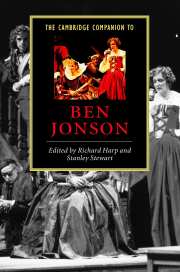Book contents
- Frontmatter
- 1 True relation
- 2 Jonson's London and its theatres
- 3 Jonson and the court
- 4 Ben Jonson and learning
- 5 Jonson's satiric styles
- 6 The major comedies
- 7 Jonson's late plays
- 8 Jonson and Shakespeare and the rhythm of verse
- 9 Jonson's poetry
- 10 Jonson and the arts
- 11 Ben Jonson's Folio of 1616
- 12 Jonson's classicism
- 13 Jonson's criticism
- 14 Jonson's critical heritage
- Bibliography
- Index
2 - Jonson's London and its theatres
Published online by Cambridge University Press: 28 May 2006
- Frontmatter
- 1 True relation
- 2 Jonson's London and its theatres
- 3 Jonson and the court
- 4 Ben Jonson and learning
- 5 Jonson's satiric styles
- 6 The major comedies
- 7 Jonson's late plays
- 8 Jonson and Shakespeare and the rhythm of verse
- 9 Jonson's poetry
- 10 Jonson and the arts
- 11 Ben Jonson's Folio of 1616
- 12 Jonson's classicism
- 13 Jonson's criticism
- 14 Jonson's critical heritage
- Bibliography
- Index
Summary
Jonsonian topographies
Ben Jonson was one of the more traveled dramatists of the English Renaissance. He crossed the Channel twice, as a footsoldier in the Low Countries in the 1590s, and as chaperone for the visit of Sir Walter Raleigh's son to Paris in 1613. At home his most notable journey was his 1618-19 walk to Edinburgh and back, during which he laid plans for a Loch Lomond pastoral and a poem on the wonders of Scotland. Among other exploits, he visited Sir Robert Cotton in Huntingdonshire in 1603, and turned up in Rutland in 1621. But it is entirely characteristic that while away from the city, his imagination harked back to it. In Scotland, he dubbed Edinburgh “Britain's other eye” (HS 1: 143), implying that England's capital was eye number one. Incidents from the Paris trip became source material for Bartholomew Fair. At Cotton's house, he was unable to forget the danger his family stood in from the plague, and was troubled by dreams of home (HS 1: 139-40).
- Type
- Chapter
- Information
- The Cambridge Companion to Ben Jonson , pp. 15 - 29Publisher: Cambridge University PressPrint publication year: 2000
- 4
- Cited by

